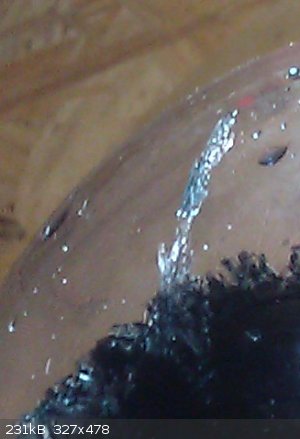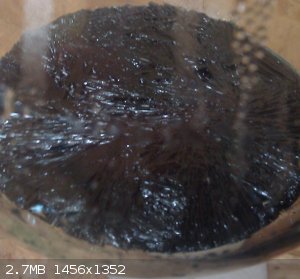Natures Natrium
Hazard to Others
  
Posts: 163
Registered: 22-12-2004
Member Is Offline
Mood: No Mood
|
|
Old phenol has acquired a bluish hue
Greetings,
About a year ago I made some phenol via the pyrolytic decarboxylation of salicylic acid.
Due to time and personal incompetence, the phenol has sat in a loosely stoppered (ground glass) round-bottom flask for most of that time, being
exposed to the temperature and humidity changes of the seasons.
On coming back to it, it has acquired the bluish hue as seen in the photos below.
My first reaction was to simply re-distill it, but in dealing with an unknown its best to research a bit before proceeding.
Unfortunately, search terms involving "blue" and "phenol" turn up almost exclusively topics related to the pH visual indicator.
Has anyone experience or knowledge regarding this?
 
\"The man who does not read good books has no advantage over the man who cannot read them.\" - Mark Twain (1835-1910)
|
|
|
Magpie
lab constructor
    
Posts: 5939
Registered: 1-11-2003
Location: USA
Member Is Offline
Mood: Chemistry: the subtle science.
|
|
I made 1-2mL of phenol by this route:
benzene>nitrobenzene>aniline>phenol
I placed it in a clear vial, capped it, and placed it on a shelf over my lab bench. After a short time it turned an amber/brown. I like to sniff it
occaisionaly. 
I have a large amount of phenol (~500g) that I bought from Dagger when they were having a really good sale some years ago. I have not opened it yet
so I can't tell you if it has become colored.
The single most important condition for a successful synthesis is good mixing - Nicodem
|
|
|
Natures Natrium
Hazard to Others
  
Posts: 163
Registered: 22-12-2004
Member Is Offline
Mood: No Mood
|
|
I have a few theories, off the top of my head, shots in the dark:
1. This is the result of slow oxidation over the course of the year.
* Distillation should provide evidence that there has been chemical change
2. This is a complex formed between phenol, oxygen, and possibly water.
* Distillation might be hazardous?
* Treatment of a sample with citric acid and/or sodium metabisulfite might produce decolorization, possibly indicating reduction of a reversibly
oxidized species.
3. This is a complex between phenol and some trace metal, possibly iron.
3a. I generally use commercial grade acetone to clean flasks. Since the acetone came from a steel can, perhaps it contained trace amounts of iron.
3b. Perhaps the phenol still had traces of salicyclic acid in it, and that has complexed with the possible iron, or with the phenol itself.
* Distillation should break the complex and help to isolate pure compounds.
* Treatment of a sample with dilute HCl might pull the iron or other metal away from the phenol, giving a visual decolorization as indicator.
As always, open to critiques, suggestions, and references. 
In addition to google searches, I checked the following references for mention of a bluish phenol complex:
International Chemical Series, The Principles of Organic Chemistry James F Norris 1931
Vogels Practical Organic Chemistry, v3 and v5
Tried to look in:
Systematic Organic Chemistry by Cumming Hopper Wheeler
but my copy lacks an index. Despite the appearance of having an absolute wealth of information, the lack of an index makes it nearly useless.
\"The man who does not read good books has no advantage over the man who cannot read them.\" - Mark Twain (1835-1910)
|
|
|
Natures Natrium
Hazard to Others
  
Posts: 163
Registered: 22-12-2004
Member Is Offline
Mood: No Mood
|
|
Results of above tests:
1. Heating a small amount in a test tube caused the phenol to enter a heavy, vapor white gaseous state that did not escape the test tube. It is very
cold in my lab, and on slow condensation the phenol was clear. It did not recrystallize (as of yet). There was left on the bottom of the tube a
distinct blue material that was not evaporating at the phenol boiling point or slightly above. It also did not dissolve into the liquid phenol as the
vapor condensed.
2. Treatment of a small amount in a test tube with a spatula tip of sodium bisulfite caused the solution to turn clear. No visible precipitate or
reaction.
3. Treatment of a small amount in a test tube with a drop or two of sulfuric acid also caused the solution to turn clear, although it took a bit
longer. No visible precipitate or reaction.
EDIT: After several hours in the cold, the solution developed a distinctly pink hue.
Although I cant say precisely what the blue compound is, I feel fairly confident about redistilling the phenol for purity.
As a possible contaminant, I also remembered that I use a spray-on teflon lubricant for ground glass joints sometimes, and that may have been the case
here. The lubricant did not last the year, and I was again reminded why chemicals shouldn't be stored in reaction flasks for long periods of time.
The stopper came free finally with a little propane blow torch and a lot of gentle yet firm tugging. One of my least favorite chemistry related
activities.
As for the smell of phenol, I rate it slightly above neutral. Its not unpleasant but I don't particularly wish to smell it either.
[Edited on 27-2-2015 by Natures Natrium]
\"The man who does not read good books has no advantage over the man who cannot read them.\" - Mark Twain (1835-1910)
|
|
|
Hawkguy
Hazard to Others
  
Posts: 326
Registered: 10-10-2014
Location: British Columbia (Canada eh!)
Member Is Offline
Mood: Body is Ready
|
|
My biggest question is why the phenol is being sniffed.
|
|
|
hissingnoise
International Hazard
    
Posts: 3940
Registered: 26-12-2002
Member Is Offline
Mood: Pulverulescent!
|
|
Because it transports you back to childhood ─ watching major roadworks in a haze of tarry vapours . . . ?
|
|
|
Natures Natrium
Hazard to Others
  
Posts: 163
Registered: 22-12-2004
Member Is Offline
Mood: No Mood
|
|
It does remind me of my childhood, although not roadwork. Rather it is a major component in Camphophenique, a mixture of camphor and phenol in a
eucalyptus oil base that was used to treat sores, burns, insect bites, and other wounds. It is an anti-septic and pain relieving compound.
My grandmother used the stuff regularly.
\"The man who does not read good books has no advantage over the man who cannot read them.\" - Mark Twain (1835-1910)
|
|
|
Mailinmypocket
International Hazard
    
Posts: 1351
Registered: 12-5-2011
Member Is Offline
Mood: No Mood
|
|
My favorite medicated lip balm contains 0.53% phenol, stuff works miracles! Occasionally wafting the odor from a jar of phenol and taking a cautious
sniff is delightful, one of my favorite smells in the lab.
Note to self: Tare the damned flask.
|
|
|
Praxichys
International Hazard
    
Posts: 1063
Registered: 31-7-2013
Location: Detroit, Michigan, USA
Member Is Offline
Mood: Coprecipitated
|
|
Agreed. I have some chloraseptic throat spray that contains 1.4% phenol and I love the smell. It is intense considering it is meant to be sprayed into
the back of one's throat.
|
|
|
Magpie
lab constructor
    
Posts: 5939
Registered: 1-11-2003
Location: USA
Member Is Offline
Mood: Chemistry: the subtle science.
|
|
The smell indicates success in doing a 4-pot synthetic sequence early in my home chemistry hobby.
It has a bracing, medicinal, and unique smell.
I agree that the sniff should be cautious.
The single most important condition for a successful synthesis is good mixing - Nicodem
|
|
|
Dr.Bob
International Hazard
    
Posts: 2659
Registered: 26-1-2011
Location: USA - NC
Member Is Offline
Mood: No Mood
|
|
I would guess that the blue is from some byproduct of the aniline traces likely left in the phenol. Phenol is pretty stable, I have seen years old
stuff that was clear of color. But aniline and its oxidation by-products are often colored and only a small trace could provide a strong color.
A simple distillation or sublimation would purify the phenol, but it may not even be necessary for most chemistry. I use aniline compounds with a
trace of color often and once I purify the product, they are often 99+% pure. Aliphatic amines are much more of a problem with being impure.
However, electron rich anilines are much less stable, so it depends on what you have.
|
|
|
Magpie
lab constructor
    
Posts: 5939
Registered: 1-11-2003
Location: USA
Member Is Offline
Mood: Chemistry: the subtle science.
|
|
I have some old aniline that has a brown cast. I used 1mL of it "as is" to test 1mL of my homemade acetyl chloride, thereby making acetanilide.
After filtering and recrystallizing the product was crystal clear. I determined the melting point to be 114-115°C. (Lange handbook value =
113-114°C.)
The single most important condition for a successful synthesis is good mixing - Nicodem
|
|
|
Natures Natrium
Hazard to Others
  
Posts: 163
Registered: 22-12-2004
Member Is Offline
Mood: No Mood
|
|
My phenol was produced via the pyrolytic decarboxylation of salicylic acid. Given my observations above, I am inclined to think it is a strongly
colored salt, as it does not lose its color on strong heating (> bp of phenol) with a propane flame.
Thinking about the brown aniline, it occurs to me that a large database containing only information about how reagents age and how to purify or
recover them would useful. Unfortunately I have neither the time nor experience to assemble such a repository.
\"The man who does not read good books has no advantage over the man who cannot read them.\" - Mark Twain (1835-1910)
|
|
|
Zephyr
Hazard to Others
  
Posts: 341
Registered: 30-8-2013
Location: Seattle, WA
Member Is Offline
|
|
Nice photos!
My phenol has also discolored, but it has turned an alarming red:

I agree with 12AX7's theory, which could have similarily happened to your sample:
| Quote: |
Not sure what's turning it red, but there are a lot of things that can polymerize with the stuff, so it could very well be a condensation product.
|
|
|
|